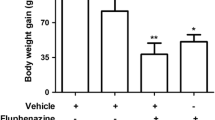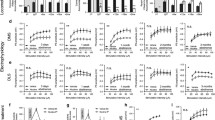Abstract
In order to relate the effects of pharmacological intervention to neuroleptic induced increases in oral activity rats were treated continuously (7 mg/kg per week) or discontinuously (7 mg/kg per week or 2 mg/kg per week) with haloperidol for 6 months. Only the two intermittently treated groups developed persisting increases in vacuous chewing movements (VCM) following drug withdrawal. Opposed to control animals and continuously treated rats, the discontinuously treated groups demonstrated significant elevation in mouth movements following stimulation with the dopamine (DA) D1 receptor agonist SK&F 38393 (23 mg/kg), whereas they did not response to an acute challenge with the selective DA D1 receptor antagonist NNC-756 (0.1 mg/kg). The DA D2 receptor antagonist raclopride (1 mg/kg) provoked a general fall in VCM; however, this was only significant in rats treated intermittently with haloperidol 7 mg/kg per week and in control rats. Intermittent neuroleptic treatment also increased apomorphine-induced stereotypy. The effect of challenge with the anticholinergic drug scopolamine (0.25 mg/kg) was not related to oral activity; furthermore, the finding of severe agitation in rats tested with the latter drug points to caution in the interpretation of rating of rats treated with anticholinergics. These results support that intermittent ingestion of neuroleptic drugs lead to long-lasting increases in VCM. They also suggest a relation of persisting elevated oral activity to supersensitivity to DA receptor agonists, as opposed to subsensitivity to D1 receptor antagonists.
Similar content being viewed by others
References
Antelman SM (1975) Tail pinch induced eating in sated rats which appears to depend on nigrostriatal dopamine. Science 189:731–733
Belmarker RH, Elami A, Bannet J (1985) Intermittent treatment with droperidol, a short-acting neuroleptic, increases behavioural dopamine receptor sensitivity. In: Casey DE, Chase T, Christensen AV, Gerlach J (eds) Dyskinesia: research and treatment. Springer, Berlin, pp 194–199
Buckland PR, O'Donovan MC, McGuffin P (1992) Changes in dopamine D1, D2 and D3 receptor MRNA levels in rat brain following antipsychotic treatment. Psychopharmacology 106:479–483
Carey RJ, DeVeaugh-Geiss J (1984) Treatment schedule as a determinant of the development of tolerance to haloperidol. Psychopharmacology 82:164–167
Collins P, Broeckkamp CLE, Jenner P, Marsden CD (1991) Drugs acting at D-1 and D2-dopamine receptors induce identical purposeless chewing in rats which can be differentiated by cholinergic manipulation. Psychopharmacology 103:503–512
Csernansky JG, Bellows EP, Barnes DE, Lombrozo L (1990) Sensitization versus tolerance to the dopamine turnover-elevating effects of haloperidol: the effect of regular/intermittent dosing. Psychopharmacology 101:519–524
Diana M, Collu M, Mura A, Gessa GL (1992) Haloperidol-induced vacuous chewing in rats: suppression by α-methyl-tyrosine. Eur J Pharmacol 211:415–419
Ellison G, Johansson P, Levin E, See R, Gunne L (1988) Chronic neuroleptics alter the effects of the D1 agonist SK&F 38393 and the D2 agonist LY171555 on oral movements in rats. Psychopharmacology 96:253–257
Gerlach J, Casey DE (1988) Tardive dyskinesia. Acta Psychiatr Scand 77:369–378
Gerlach J, Reisby N, Randrup A (1974) Dopaminergic hypersensitivity and cholinergic hypofunction in the pathophysiology of tardive dyskinesia. Psychopharmacologia 34:21–35
Glenthøj B, Hemmingsen R (1989) Intermittent neuroleptic treatment induces long-lasting abnormal mouthing in the rat. Eur J Pharmacol 164:393–396
Glenthøj B, Hemmingsen R (1991) Development of vacuous chewing movements in rats: role of housing environment. Life Sci 48:2137–2140
Glenthøj B, Arnt J, Hyttel J (1990a) Effect of a dopamine D-1 agonist in rats treated chronically with zuclopenthixol. Life Sci 47:1339–1346
Glenthøj B, Hemmingsen R, Allerup P, Bolwig TG (1990b) Intermittent versus continuous neuroleptic treatment in a rat model. Eur J Pharmacol 190:275–286
Glenthøj B, Hemmingsen R, Barry DI, Allerup P, Bruhn T, Bolwig TG (1993) Electrical kindling of rats treated discontinuously or continuously with haloperidol. Eur J Pharmacol 236:401–409
Gunne LM, Andersson U, Bondesson U, Johansson P (1986) Spontaneous chewing movements in rats during acute and chronic antipsychotic drug administration. Pharmacol Biochem Behav 25:897–901
Johansson P, Levin E, Gunne L, Ellison G (1987) Opposite effects of D1 and D2 agonist on oral movements in rats. Eur J Pharmacol 134:83–88
Johansson P, Casey DE, Gunne LM (1986) Dose-dependent increases in spontaneous chewing rates during long-term administration of haloperidol but not clozapine. Psychopharmacol Bull 22:1017–1019
Kalivas PW, Duffy P (1988) Effects of daily cocaine and morphine treatment on somatodendritic and terminal field dopamine release. J Neurochem 50:1498–1504
Kalivas PW, Duffy P, Abhold R, Dilts RP (1988) Sensitization of mesolimbic dopamine neurons by neuropeptides and stress. In: Kalivas PW, Barnes CD (eds) Sensitization in the nervous system. Telford, NJ, USA, pp 119–144
Koller WC (1984) Effects of intermittent haloperidol treatment on dopamine receptor sensitivity in guinea pigs. Psychopharmacology 84:98–100
Laruelle M, Jaskiw GE, Lipska BK, Kolachana B, Casanova MF, Kleinman JE, Weinberger DR (1992) D1 and D2 receptor modulation in rat striatum and nucleus accumbens after subchronic and chronic haloperidol treatment. Brain Res 575:47–56
Levin ED, See RE, South D (1989a) Effects of dopamine D1 and D2 receptor antagonists on oral activity in rats. Pharmacol Biochem Behav 34:43–48
Levin ED, Ellison GD, See RE, South D, Young E (1989b) D1 and D2 dopamine receptor interactions with pilocarpine-induced oral activity in rats. Pharmacol Biochem Behav 33:501–505
Lublin H, Gerlach J (1988) Behavioural effects of dopamine D-1 and D-2 receptor agonists in monkeys previously treated with haloperidol. Eur J Pharmacol 153:239–245
Memo M, Pizzi M, Missale C, Carruba MO, Spano PF (1987) Modification of the function of D1 and D2 dopamine receptors in striatum and nucleus accumbens of rats chronically treated with haloperidol. Neuropharmacology 26:477–480
Murugaiah K, Fleminger S, Hall MD, Theodorou A, Jenner P, Marsden CD (1984) Alterations in different populations of striatal, dopamine receptors produced by 18 months continuous administration of cis- or trans-flupenthixol to rats. Neuropharmacology 23:599–609
Nishikawa T, Takashima M, Toru M (1983) Increased [3H]kainic acid binding in the prefrontal cortex in schizophrenia. Neurosci Lett 40:245–250
Peacock L, Lublin H, Gerlach J (1990) The effects of dopamine D1 and D2 receptor agonists and antagonists in monkeys withdrawn from long-term neuroleptic treatment. Eur J Pharmacol 186:49–59
Robinson TE, Becker JB (1982) Behavioural sensitization is accompanied by enhancement in amphetamine stimulated dopamine release from striatal tissue in vitro. Eur J Pharmacol 85:253–254
Robinson TE, Becker JB (1986) Enduring changes in brain and behaviour produced by chronic amphetamine administration: a review and evaluation of animal models of amphetamine psychosis. Brain Res Rev 11:157–198
Robinson TE, Jurson PA, Bennett JA, Bentgen KM (1988) Persistent sensitization of dopamine neurotransmission in ventral striatum (nucleus accumbens) produced by prior experience with (+)-amphetamine: a microdialysis study in freely moving rats. Brain Res 462:211–222
Rubinstein M, Gershanik O, Stefano FJE (1988) Different roles of D-1 and D-2 dopamine receptors involved in locomotor activity of supersensitive mice. Eur J Pharmacol 148:419–426
Rupniak NMJ, Jenner P, Marsden CD (1983) Cholinergic manipulation of perioral behaviour induced by chronic neuroleptic administration to rats. Psychopharmacology 79:226–230
Rupniak NMJ, Jenner P, Marsden CD (1985) Pharmacological characterisation of spontaneous or drug-associated purposeless chewing movements in rats. Psychopharmacology 85:71–79
Rupniak NMJ, Jenner P, Marsden CD (1986) Acute dystonia induced by neuroleptic drugs. Psychopharmacology 88:403–419
Sant WW, Ellison G (1984) Drug holidays alter onset of oral movements in rats following chronic haloperidol. Biol Psychiatry 19:95–99
See RE, Ellison G (1990) Intermittent and continuous haloperidol regimens produce different types of oral dyskinesias in rats. Psychopharmacology 100:404–412
Stroessl AJ, Dourish CT, Iversen SD (1989) Chronic neuroleptic-induced mouth movements in the rat: suppression by CCK and selective dopamine D1 and D2 receptor antagonists. Psychopharmacology 98:372–379
Tamminga CA, Dale JM, Goodman L, Kaneda H, Kaneda N (1990) Neuroleptic-induced vacuous chewing movements as an animal model of tardive dyskinesia: a study in three rat strains. Psychopharmacology 102:474–478
Waddington JL (1990) Spontaneous orofacial movements induced in rodents by very long-term neuroleptic drug administration. Phenomenology, pathophysiology and putative relationship to tardive dyskinesia. Psychopharmacology 101:431–447
Waddington JL, Cross AJ, Gamble SJ, Bourne RC (1983) Spontaneous orofacial dyskinesia and dopaminergic function in rats after 6 months of neuroleptic treatment. Science 220:530–532
Waddington JL, Youssef HA, O'Boyle KM, Molloy AG (1986) A reappraisal of abnormal, involuntary movements (tardive dyskinesia) in schizophrenia and other disorders: animal models and alternative hypotheses. In: Winslow W, Markstein R (eds) The neurobiology of dopamine system. Manchester University Press, Manchester, pp 266–286
Waddington JL, Molloy AG, O'Boyle KM (1988) Behavioural effects of long-term treatment with further typical neuroleptics and selective D-2 dopamine receptor antagonists in young vs aged animals. In: Sandler M, Dahlstrom A, Belmarker R (eds) Progress in catecholamine research. Part B: central aspects. Liss, New York, pp 43–46
Wirshing WC, Freidenberg DL, Cummings JL, Bartzokis G (1989) Effects of anticholinergic agents on patients with tardive dyskinesia and concomitant drug-induced parkinsonism. J Clin Psychopharmacol 9:407–411
Author information
Authors and Affiliations
Rights and permissions
About this article
Cite this article
Glenthøj, B. Persistent vacuous chewing in rats following neuroleptic treatment: relationship to dopaminergic and cholinergic function. Psychopharmacology 113, 157–166 (1993). https://doi.org/10.1007/BF02245692
Received:
Revised:
Issue Date:
DOI: https://doi.org/10.1007/BF02245692




